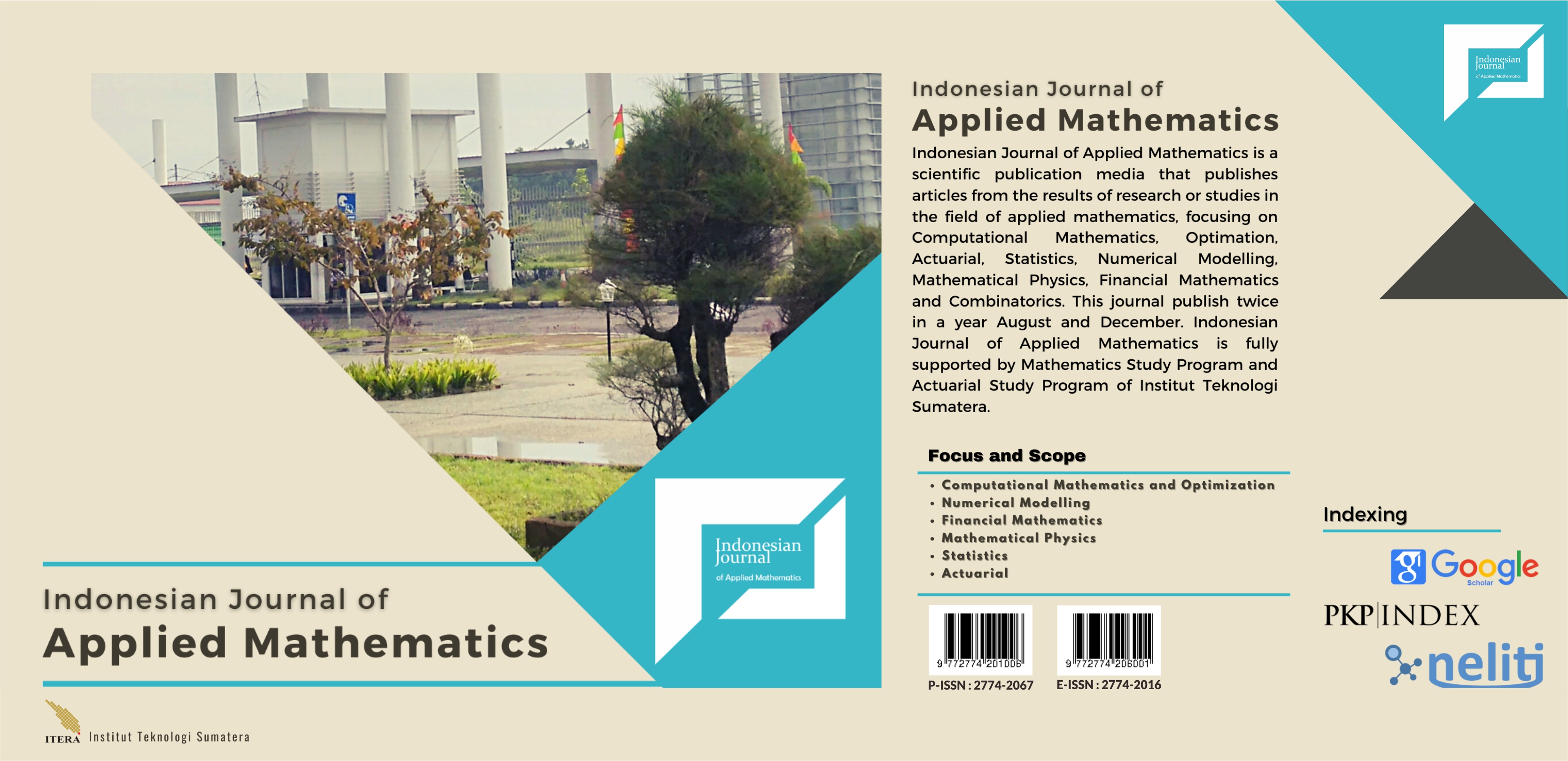MATHEMATICS MODEL SIRS-SI OF TRANSMISSION DENGUE VIRUS CONSIDERING FUMIGATION, VACCINATION AND TREATMEN IN CASE OF TANGERANG CITY
Abstract
Abstract: In this paper, we construct a mathematical model SIRS-SI transmission dengue fever considering fumigation, vaccination and treatment in case Tangerang City. Background why this research has to do because in Tangerang City the case of dengue fever is pretty lot. Method in this research is using compartment model and create differential equation system. We also do some analyze the model like determining free disease equilibrium point and endemic equilibrium point. We also determining basic reproduction number and making analyze stability of the model around equilibrium points. We also do simulation of the model and the result; model is local asymptotic stable in area free disease equilibrium point and local asymptotic stable in area endemic equilibrium point. Because R0 <1 for free disease equilibrium point, then there are no endemic disease, but because R0 > 1 for endemic equilibrium point then situation is in endemic dengue fever.
Keywords: SIRS, Fumigation, Vaccination, Treatment, Dengue
Downloads
References
[2] Baihaqi, M. A., Al-Kubro, P. B., Andyani, R. A., Setyawati, Y., Rahayu, U. B., & Fitriyya, M. (2023). Pola Penyebaran Penyakit Demam Berdarah dengan Model SIR di Madiun Tahun 2020-2022. Jurnal Keilmuan Dan Keislaman, 1–9. https://doi.org/10.23917/jkk.v3i1.171
[3] Chanprasopchai, P., Tang, I. M., & Pongsumpun, P. (2018). SIR Model for Dengue Disease with Effect of Dengue Vaccination. Computational and Mathematical Methods in Medicine, 2018. https://doi.org/10.1155/2018/9861572
[4] Hosny, R. A., Abu-Gdairi, R., & El-Bably, M. K. (2024). Enhancing Dengue fever diagnosis with generalized rough sets: Utilizing initial-neighborhoods and ideals. Alexandria Engineering Journal, 94, 68–79. https://doi.org/10.1016/j.aej.2024.03.028
[5] Hu, L., Tang, M., Wu, Z., Xi, Z., & Yu, J. (2019). The threshold infection level for Wolbachia invasion in random environments. Journal of Differential Equations, 266(7), 4377–4393. https://doi.org/10.1016/j.jde.2018.09.035
[6] Khan, M. A., & Fatmawati. (2021). Dengue infection modeling and its optimal control analysis in East Java, Indonesia. Heliyon, 7(1). https://doi.org/10.1016/j.heliyon.2021.e06023
[7] Mendoza, A. P. (2024). Dengue incidence forecasting model in Magalang, Pampanga using time series analysis. Informatics in Medicine Unlocked, 44. https://doi.org/10.1016/j.imu.2023.101439
[8] Naikteas Bano, E., Leltakaeb, A., & Frengky Obe, L. (n.d.). STATMAT (Jurnal Statistika dan Matematika ANALISIS KESTABILAN MODEL PENYEBARAN PENYAKIT DEMAM BERDARAH DENGUE (DBD) TIPE SIR MEMAKAI LARVASIDA. 4(1), 9–27.
[9] Ndii, M. Z. (2022). The effects of vaccination, vector controls and media on dengue transmission dynamics with a seasonally varying mosquito population. Results in Physics, 34. https://doi.org/10.1016/j.rinp.2022.105298
[10] Ndii, M. Z., Mage, A. R., Messakh, J. J., & Djahi, B. S. (2020). Optimal vaccination strategy for dengue transmission in Kupang city, Indonesia. Heliyon, 6(11). https://doi.org/10.1016/j.heliyon.2020.e05345
[11] Paupy, C., Delatte, H., Bagny, L., Corbel, V., & Fontenille, D. (2009). Aedes albopictus, an arbovirus vector: From the darkness to the light. Microbes and Infection, 11(14–15), 1177–1185. https://doi.org/10.1016/j.micinf.2009.05.005
[12] Rubio, F. A., & Yang, H. M. (2022). A mathematical model to evaluate the role of memory B and T cells in heterologous secondary dengue infection. Journal of Theoretical Biology, 534. https://doi.org/10.1016/j.jtbi.2021.110961
[13] Rustam, F., Reshi, A. A., Aljedaani, W., Alhossan, A., Ishaq, A., Shafi, S., Lee, E., Alrabiah, Z., Alsuwailem, H., Ahmad, A., & Rupapara, V. (2022). Vector mosquito image classification using novel RIFS feature selection and machine learning models for disease epidemiology. Saudi Journal of Biological Sciences, 29(1), 583–594. https://doi.org/10.1016/j.sjbs.2021.09.021
[14] Sanusi, W., Badwi, N., Zaki, A., Sidjara, S., Sari, N., Pratama, M. I., & Side, S. (2021). Analysis and Simulation of SIRS Model for Dengue Fever Transmission in South Sulawesi, Indonesia. Journal of Applied Mathematics, 2021. https://doi.org/10.1155/2021/2918080
[15] Side, S., Alvioni Bani, dan, Matematika, J., & Matematika dan Ilmu Pengetahuan Alam, F. (2018). Modifikasi Model SIR pada Penyebaran Penyakit Demam Berdarah Dengue di Kabupaten Bone. In Journal of Mathematics (Vol. 1, Issue 2). http://www.ojs.unm.ac.id/jmathcos
[16] Side, S., Zaki, A., & Miswar. (2022). Numerical Solution of the Mathematical Model of DHF Spread using the Runge-Kutta Fourth Order Method. ARRUS Journal of Mathematics and Applied Science, 2(2), 92–100. https://doi.org/10.35877/mathscience745
[17] Soleh, M., Matematika, J., Sains dan Teknologi, F., Sultan Syarif Kasim Riau Jl Soebrantas No, U. H., & Baru, S. (2018). MODEL SIR PENYEBARAN DEMAM BERDARAH DI PEKANBARU. Jurnal Sains Matematika Dan Statistika, 4(2).
[18] Windawati, S., Shodiqin, A., & Aini, A. N. (2020). Analisis Kestabilan Model Matematika Penyebaran Penyakit Demam Berdarah dengan Pengaruh Fogging. Square : Journal of Mathematics and Mathematics Education, 2(1), 1. https://doi.org/10.21580/square.2020.2.1.5149
Copyright (c) 2024 Indonesian Journal of Applied Mathematics

This work is licensed under a Creative Commons Attribution-NonCommercial 4.0 International License.





